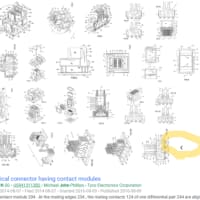US2019162560
"[0002] Brushless DC motors in the form of external rotors with sensor-controlled and sensor-less commutation are known from the prior art. In the sensor-controlled commutation a position of the rotor of the DC motor is measured, for example with optical sensors and/or Hall sensors, in order to activate the phases of a stator accordingly. This allows a virtually “judder-free” startup of the DC motor. The use of magnetic sensors suggests the dual use of the magnets of the permanent excitation as the sensor magnet. Since in the normal case only two windings of the at least three-phase stator system are ever activated, the rotor position in the case of sensor-less commutation is determined by the voltage induced in the stator winding that is currently not activated. This signal is only available when the rotor is in motion, however. The sensor-less startup is therefore particularly critical. Often, the motor is started with a fixed cycle pattern. Due to the uncertainty of the initial rotor positions this can lead to intense juddering. This behavior is not acceptable for a wide variety of applications. "
先行技術に基づき、センサ制御により整流されたり、センサレスで整流されたりするアウタロータ型のブラシレス直流モータが公知である。センサ制御による整流では、直流モータのロータの位置が、例えば光学センサおよび/またはホールセンサによって測定され、これにより、ステータの位相が相応に制御される。これによって、直流モータのほぼ「ジャークなし」の始動が可能となる。磁気センサの使用は、センサ磁石として永久励磁の磁石を二重使用することを想起させる。センサレスでの整流では、通常の場合、少なくとも三相のステータシステムの常に2つの巻線だけが制御されるので、ロータ位置の測定は、丁度制御されていないステータ巻線における誘導された電圧によって行われる。しかしながら、この信号はロータの運動時にしか提供されない。したがって、センサレスでの始動は特に問題をはらんでいる。このために、モータは固定のクロッキング方式で始動させられることが多い。初期のロータ位置が不確定であることに基づき、これによって、激しいジャークが生じてしまう。数多くの用途において、この挙動は受け入れがたい。
US8970079
"The method for sensorless determination of the position relative to the magnetic bearing of an object mounted in a magnetic bearing, in particular relative to an electromagnet in the magnetic bearing, includes the following:
actuation of at least one electromagnet in the magnetic bearing by a pulse width modulated (PWM) voltage, wherein the waveform of the pulse width modulated voltage has at least one first phase (j=1), in particular a charging up phase, and at least one second phase (j=2), in particular a discharge phase,"
磁気ベアリングに支承された物体の、磁気ベアリングに対する位置、特に磁気ベアリングの電磁石に対する位置をセンサレスで求める本発明による方法は、下記のステップを有する。
−磁気ベアリングの少なくとも1つの電磁石をパルス幅変調(PWM)された電圧によって駆動制御するステップ。その際、パルス幅変調された電圧の時間的経過は、少なくとも1つの第1段階(j=1)、特に充電段階と、少なくとも1つの第2段階(j=2)、特に放電段階とを有する。
US2002044586
"[0233] This embodiment as shown in FIG. 18 utilizes two 3 phase brushless DC motors each with a magnetic rotor contained within a metallic pressure cup which separates the stator portion of the motors from the laser gas environment as described in U.S. Pat. No. 4,950,840. In this embodiment, the pressure cup is thin-walled nickel alloy 400, 0.016 inch thick which functions as the laser gas barrier. The two motors 530 and 532 drive the same shaft and are programmed to rotate in opposite directions. Both motors are sensorless motors (i.e., they operate without position sensors). Right motor controller 534 which controls right motor 530 functions as a master controller controlling slave motor controller 536 via analog and digital signals to institute start/stop, current command, current feedback, etc. Communication with the laser controller 24A is via a RS-232 serial port into master controller 534. "
図18に示すこの実施形態では、米国特許第4,950,840号で説明されているように、2つの3相ブラシレス直流モータであって、それぞれがモータの固定子部を図18に示すようなレーザガス環境から隔離する金属製圧力カップに収容された磁気回転子を備えるものを利用することができる。この実施形態において、圧力カップは、レーザガスバリアとして機能する0.016インチ厚の薄肉ニッケル合金400である。2つのモータ530及び532は、同じ軸を駆動し、反対方向に回転するようにプログラムされる。両モータは、センサレスモータである(即ち、位置センサレスで作動する)。右モータ530を制御する右モータ制御装置534は、開始/停止、電流指令、電流フィードバック等を実施するために、アナログ・デジタル信号によってスレーブモータ制御装置536を制御するマスタ制御装置として機能する。レーザ制御装置24Aとの通信は、マスタ制御装置534へのRS−232シリアルポートを介して行われる。
US7034497
"A resolver mounted to the starter/generator rotor provides this required rotor position information but it has been identified as imposing size, weight, and complexity or unreliability penalties. Thus, it is desirable to provide the electric start function in a self-sensing or sensorless manner(*センサレスで), that is, without a resolver or other overt rotor position sensing means. Additionally, these starter/generators are sized for worst case starting conditions that may require a plurality of machines to start a single main engine at cold day conditions. It is thus required in some applications to parallel a multiplicity of starter/generators to provide full rated torque from each of these starter/generators at standstill. "
US7392565
"Thus, the production of the three phase voltages from the 3-phase motor driver circuit 166 can be referred to as either sinusoidal or trapezoidal commutation. To properly control and time the commutation to drive the rotor 30 in the desired manner, the rotor position must be accurately determined, or sensed, as it rotates. This position sensing of the rotor 30 is used as feedback to the microprocessor 174. In the preferred embodiment, the rotor position is derived in a "sensorless" manner(*センサレスで), meaning that the rotor position is derived electronically and indirectly to provide the necessary feedback to the microprocessor 174 with no additional physical sensors used about the motor."
US8638054
"Permanent magnet motors typically include a stator and a rotor that rotates within or around the stator. The speed and angular position of the rotor are commonly used to generate control signals for the motor. Traditionally, the speed and angular position of the rotor are determined via one or more rotor position sensors. More recently, techniques have been developed and used for determining the speed and angular position of the rotor sensorlessly(*センサレスで;少ない)(i.e., without direct measurement of the rotor speed or position). For example, flux of the motor may be estimated and used to estimate the rotor speed and/or position. The estimated flux is not used, however, when starting these motors. Instead, the motors are controlled without relying on estimated flux until a preset time period has elapsed, or until the motor reaches a defined speed, torque output, etc. At that point, the flux estimates are assumed to be sufficiently accurate, and the motor control begins using the estimated flux to control the motor. "



























※コメント投稿者のブログIDはブログ作成者のみに通知されます